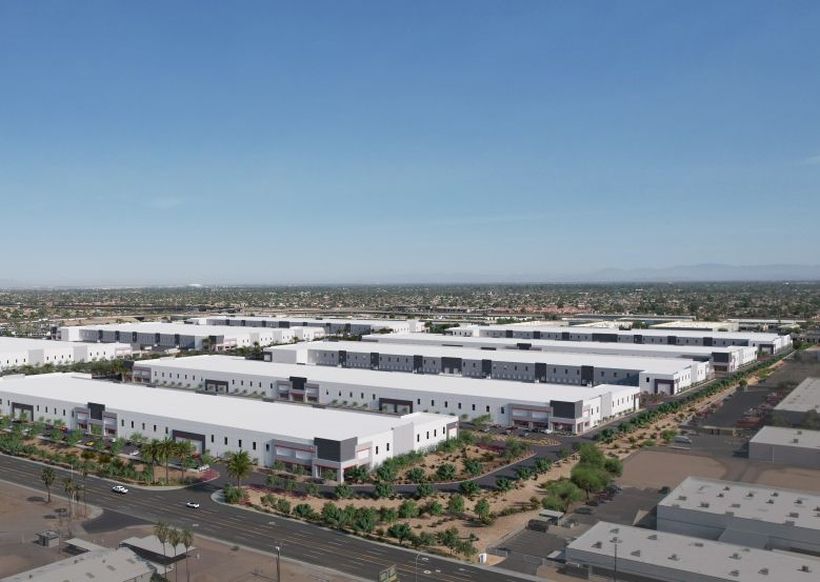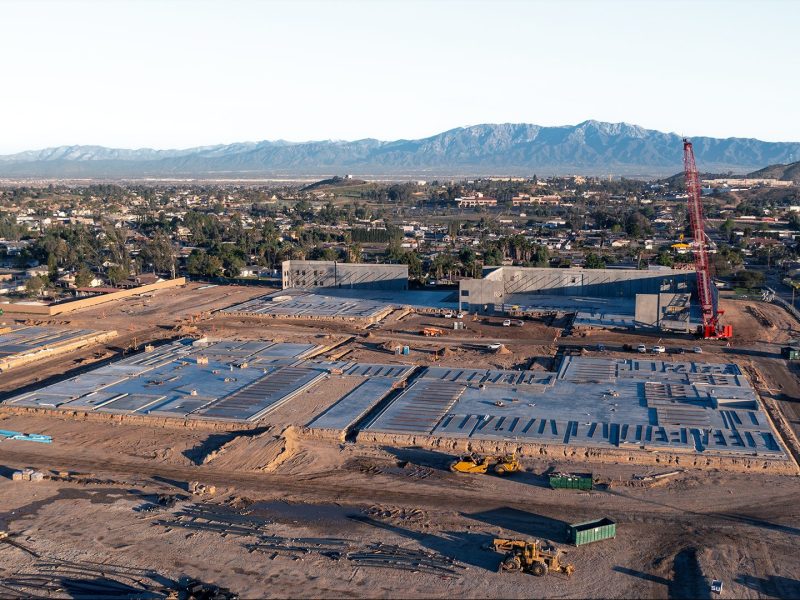Why CapRock Maintains Cautiously Optimistic Outlook for Industrial Development
President Jon Pharris on the strategy behind large-scale projects and what’s next for the region’s key markets.
Even with slightly increasing vacancy rates brought on by record levels of new supply, demand for industrial space remains strong. Developers continue to feed the pipeline, with 691 million square feet under construction across the country as of January, CommercialEdge data shows. Ten markets account for 40 percent of the development activity, according to the same data provider, with Dallas and Phoenix having the largest pipelines.
One of the companies that has been very busy lately is CapRock Partners. The firm has several megadevelopments underway in Western U.S., including in the Phoenix area, but also in the Inland Empire, historically regarded as a key industrial market.
Commercial Property Executive asked Co-Founder & President Jon Pharris to share details about his company’s largest projects, and also touch on trends shaping the Western industrial market, tenants’ needs today and the outlook for the sector that has been viewed so far as the darling of commercial real estate.
READ ALSO: Semiconductor Boom Continues to Boost CRE
Construction is well underway on the initial phase of your 3.4 million-square-foot CapRock West 202 Logistics project in Phoenix. What challenges has the city’s largest spec development posed so far?
Pharris: Currently, the construction of the first five buildings—which total 2.7 million square feet—is underway, and we expect it to be completed by the summer of 2023. Despite the uncertainty in the economy, our leasing activity remains strong, and we are negotiating with several potential customers.
Developing a project of this scale is not without challenges, but our team of skilled professionals is well-equipped to navigate around them and work with all stakeholders, including municipalities and technical specialists, to find solutions.
One specific challenge we faced in developing CapRock West 202 Logistics was the requirement from the city to construct a private road that will later become a public right-of-way. Our team has coordinated with federal agencies and relocated various utilities and easements to accommodate this requirement, which was a complex task that impacted multiple properties in the Phoenix area.
A year ago, you broke ground on another large development—the 2 million-square-foot industrial project in Norco, Calif. How is that going?
Pharris: Palomino Ranch is a master-planned business park consisting of 24 buildings with a total area of approximately 2 million square feet, spread across 110 acres in the Inland Empire West. This project is being developed in three phases, and CapRock is nearing completion of the first phase, which includes eight buildings totaling 700,000 square feet. The second phase is expected to commence next year.
Located near the intersection of two heavily trafficked freeways, interstates 15 and 91, Palomino Ranch is in an infill location close to both Los Angeles and Orange County. However, in the beginning, the site posed a challenge as it lacked the sufficient infrastructure to support a large-scale development like Palomino Ranch.
Given its position within the heart of the Norco community, it was important for us to create a thoughtful business park that would not only cater to the needs of the area’s growing population but also respect Norco’s history and heritage. To this end, we worked closely with the local community and elected officials to enhance the infrastructure surrounding the project site. Our team has incorporated several improvements in the development of Palomino Ranch, such as widening adjacent streets, making regional storm drain improvements, installing streetlights, creating a network of horse trails, and incorporating a western motif to reflect the equestrian lifestyle of the community. These initiatives not only help to improve the city of Norco but also offer amenities that future tenants would expect.
CapRock believes that Palomino Ranch will be a landmark development that will contribute to the growth and prosperity of the Norco community.
You have a lot of experience when it comes to working on megadevelopments. How do you tackle the multitude of problems that come in every day when developing projects of such magnitude?
Pharris: An important aspect of building a successful megadevelopment is initiating and maintaining effective communication and collaboration with all stakeholders from a project’s beginning. We make it a priority to keep all parties involved, including elected officials, community representatives, contractors, investors, brokers and lenders, informed and engaged throughout the development process.
What do industrial tenants want today? Are there any changes you’ve seen in pre-leasing activity?
Pharris: Given the sustained high demand and low vacancy rates for industrial space nationally, coupled with the fact that CapRock invests and develops in some of the tightest submarkets in the country, we continue to see strong pre-leasing activity.
Tenant needs are evolving as the economy continues to adjust after the supply chain shocks of COVID-19. As corporations shift their distribution strategies, demand continues for modern, sustainable, energy-efficient facilities in more locations throughout the West.
To meet the demands of tomorrow’s logistics, distribution and manufacturing corporations, CapRock is ‘futureproofing’ its properties as much as possible by incorporating features such as increased clear heights, ample trailer storage, accessible power, secure truck courts, adequate parking, improved traffic flow and sustainable landscaping. Moreover, CapRock places great importance on environmental stewardship, and we are committed to designing each project in a way that minimizes the impact on the natural environment, while meeting or exceeding environmental mandates.
Phoenix and the Inland Empire are two of the areas that you’re most active in. What would you say are each of these markets’ most in demand areas today? How do they compare to each other?
Pharris: While they are separate industrial markets, California’s Inland Empire and Phoenix work congruently as an integral part of the North American supply chain. This is mainly due to their connection and proximity to the Ports of Los Angeles and Long Beach.
In recent years, Phoenix has emerged as a premier destination for Fortune 1000 companies looking to increase their inventory and distribution capacities. This is supported by the city’s rapid population growth, strong economic fundamentals, business-friendly environment, temperate climate and lack of available product throughout California’s major markets. Its geographic position—within a single-day’s drive to primary consumer markets and logistics hubs in Southern California, Dallas, Denver and Salt Lake City—has led it to become a critical logistics node.
Compared to California’s land-constrained markets, Phoenix’s ample supply of developable land offers more opportunities for growth at a lower cost. This is reflected in the leasing rates for industrial properties, which have increased by about a third of the rate seen in California over the past 12 to 18 months.
In California, population centers are highly land constrained and industrial real estate demand is exceeding supply. The Inland Empire West and East submarkets are now considered infill, and tenants seeking big box distribution centers in excess of 500,000 square feet are evaluating projects further east along the I-10 corridor in Beaumont, Banning and the Coachella Valley, as well as some locations in the High Desert.
Most of the tenant activity in Phoenix is concentrated in the Southwest Valley submarket or Loop 303 corridor due to its proximity to California and access to a high-quality labor force. Phoenix’s Southeast Valley submarket is capturing approximately one third of the MSA’s tenant demand due to the presence of a highly educated workforce and its proximity to Queen Creek, one of the fastest-growing cities in the U.S.
Are there any trends that are bound to continue to define these metros’ industrial markets in 2023 and beyond?
Pharris: In California, the activity in and around the port markets supports a sustained demand for modern, efficient industrial warehouse space. However, creating a new supply of industrial properties in the incredibly constrained Inland Empire market will likely be challenging for the foreseeable future due to the region’s high development costs, land scarcity, government regulations and multi-year process to obtain entitlements. This will continue to place upward pressure on market rents and property valuations.
Phoenix is a beneficiary of these issues in California as businesses seek solutions to their industrial space needs. This logistics market serves as an extension of the Inland Empire in many ways and also an alternative. For expanding businesses, Phoenix offers a growing population, diverse economy, significant corporate investment such as the $60 billion project by TSMC, and the presence of other major employers like Intel that contribute to the MSA’s ongoing job growth and economic development, further driving demand for industrial space.
On a broader perspective, what are your expectations for the industrial sector going forward? How do you expect the brewing downturn to play out for the sector?
Pharris: CapRock is approaching the industrial real estate sector with cautious optimism. Despite the possibility of a recession, the industrial sector is entering this period with healthy fundamentals, including strong leasing activity and high corporate demand. As the economy evolves, we expect that certain development projects in the market may be delayed or become unfeasible due to changes in financing costs and investor return expectations, leading to a balanced supply and demand in the next 12 to 24 months.
The industrial sector is benefiting from several key trends, such as the growth of e-commerce, the reshoring of manufacturing, and a desire for increased inventory to manage supply chain disruptions.
We believe that industrial real estate may be the strongest institutional real estate asset class in the current market conditions. We also recognize some potential challenges in the value-add industrial segment, particularly with properties that were acquired with floating rate debt at market peak. As these short-term loans mature, borrowers may face the need for additional capital or be forced to sell due to the projects’ weakened financial position.
READ ALSO: Top 5 Markets for Industrial Transactions
What are your goals for this year?
Pharris: CapRock Partners specializes in the acquisition, development, and management of industrial real estate properties across three platforms: value-add, opportunistic and large-scale, ground-up logistics developments. We are proud to have established partnerships with some of the top institutional investors in the industry, including sovereign wealth funds, life insurance companies, pension funds, university endowments, and more.
Our assets under management have seen substantial growth over the past year, reaching close to $3 billion at the end of 2022, and are expected to reach $4 billion by the end of 2023, with the completion of some of our ongoing developments.
As part of our strategic growth plan, we are expanding our footprint into new markets with strong economic fundamentals, starting with the establishment of a new office in the Dallas-Fort Worth area in 2022. We are now seeking to further our presence in the Central region, with a focus on Texas cities such as Dallas, Austin and Houston, as well as Denver, and will be hiring a dedicated team to lead our acquisition and development efforts in these markets.
Is there anything else about the industrial market you would like to add?
Pharris: We are keeping a close eye on the industrial real estate market in 2023 and expect to see pockets of concern in certain submarkets that may have overbuilt in the last couple of years, especially in regions that have not experienced significant rental rate growth. However, we remain cautiously optimistic about the overall outlook for the industry. Our portfolio of best-in-class industrial assets, combined with our prudent underwriting practices, allows us to weather potential market fluctuations.
Our main focus is on managing our current portfolio, completing construction on approximately 7 million square feet in the Western U.S., commencing construction on another two to three million square feet in 2023, while also pursuing acquisitions in markets with positive economic fundamentals for logistics.
As the cost of borrowing increases and loan proceeds decrease, we anticipate that there may be increased distress in the market, but we are well-prepared to navigate through any challenges.










You must be logged in to post a comment.